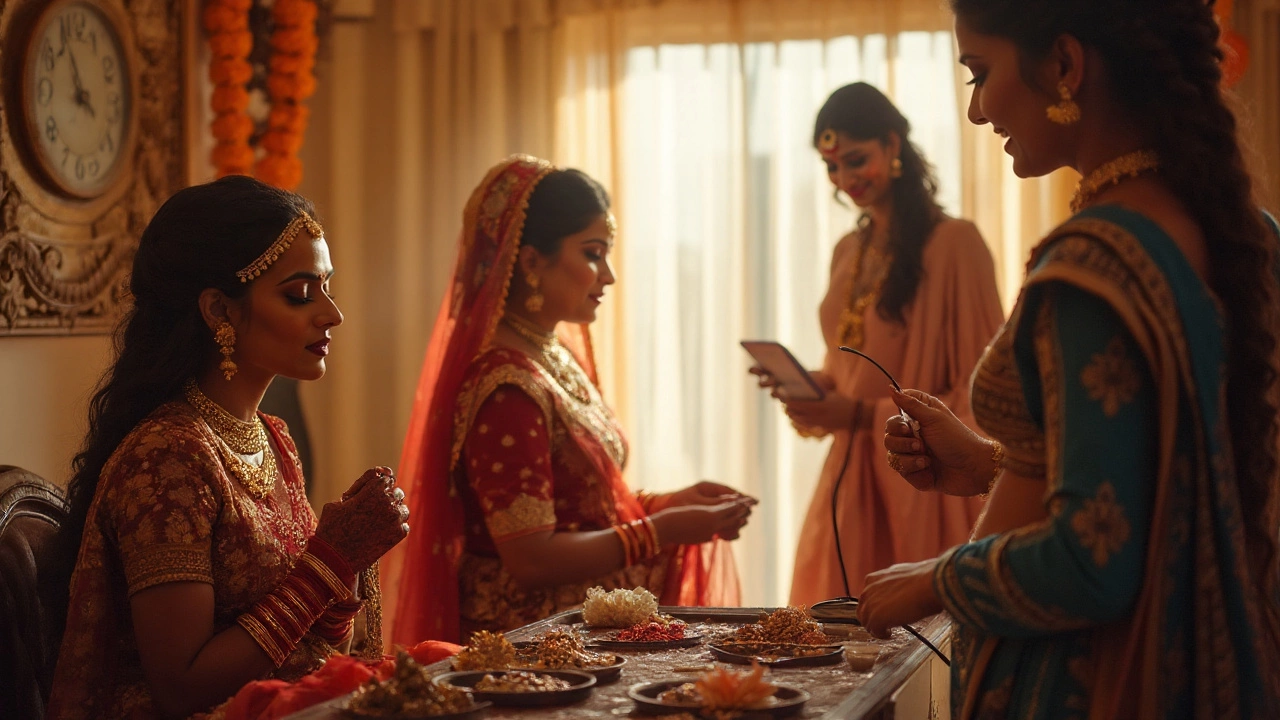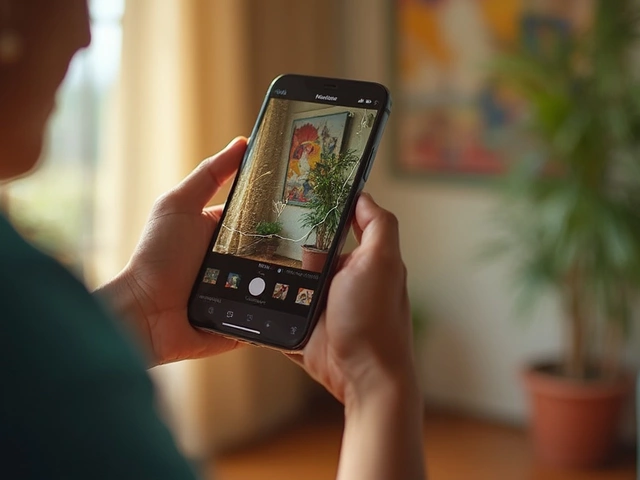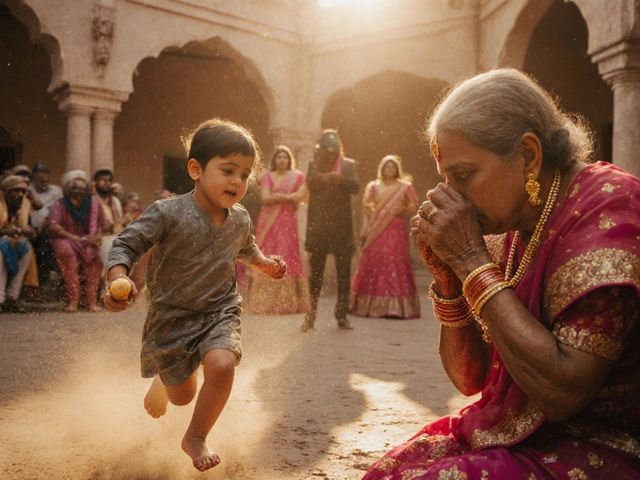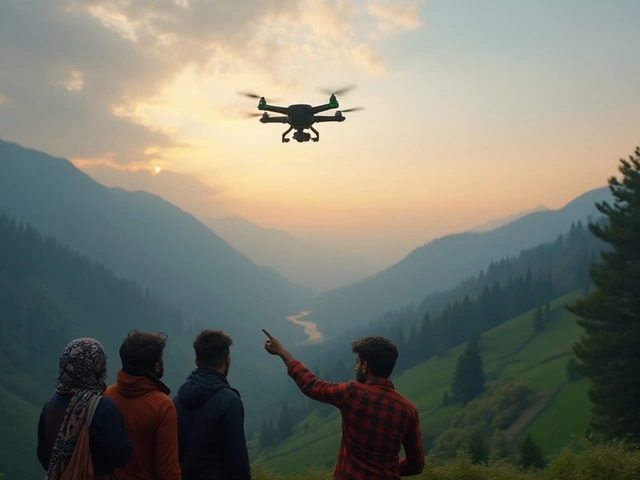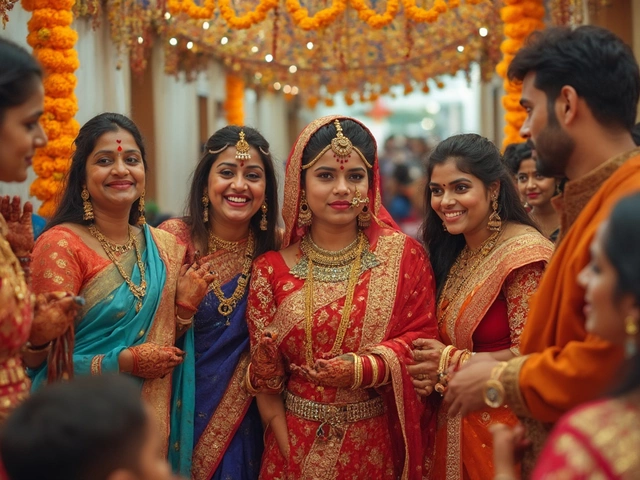The fastest way to stress on a wedding day? Cutting it too close. The ceremony start time is fixed. Everything else has to flow into it. So the real question is: what’s the smartest bride ready time that protects your ceremony, your photos, and your sanity? Here’s a clear answer you can trust, plus a step‑by‑step way to build your timeline no matter your culture, venue, or city traffic (I’m in Mumbai; I plan like the monsoon will show up uninvited).
TL;DR - The Short Answer You Can Use Right Now
Different weddings have different moving parts, but these rules hold up across church, civil, Hindu, Muslim, and fusion ceremonies:
- If you’re NOT doing a first look: be fully dressed and photo‑ready 60-90 minutes before the ceremony. That window covers touch‑ups, solo portraits, and a last bathroom break.
- If you ARE doing a first look + couple photos before: be ready 2-2.5 hours before the ceremony. You’ll need time for the reveal, couple portraits, and a few quick family photos.
- For Hindu/South Asian weddings with draping, heavy jewellery, dupatta setting, and a baraat: be ready 3-4 hours before muhurat, especially if you’re doing pre‑ritual photos or if the baraat is at your gate.
- Add travel: add the full commute time (door to door) + 15-20 minutes buffer for parking, elevator, and outfit settling.
- Always add a buffer: minimum 30 minutes. Mumbai traffic, a stuck zipper, or a late uncle-something will try you. The buffer is your calm.
Quick formula you can copy:
- Ready By Time = Ceremony Start − (Arrival Cushion 20-30 min + Pre‑Ceremony Photos 30-90 min + Buffer 30-45 min + Travel Time)
Example (no first look, same venue): 6:00 pm ceremony − (20 min arrival + 30 min portraits + 30 min buffer) ⇒ ready by 4:40 pm.
Build-Your-Own Timeline (Step by Step)
Use this once and your day falls into place. I run this exact flow when I coordinate with planners and photographers here in Mumbai.
- Lock the ceremony start time. Everything counts backward from this. If you have a muhurat, treat it as your ceremony start, not Baraat start.
- Decide your arrival cushion. Arrive 20-30 minutes before the ceremony. You’ll breathe, hydrate, maybe sign the register, and line up. Outdoor venues? Add 10 minutes for footwear and veil/dupatta adjustments.
- Choose photo strategy.
- No first look: plan 25-45 minutes for solo bridal portraits, details, and a quick parent reveal.
- First look: plan 60-90 minutes for first look, couple portraits, and a few key family shots.
- South Asian weddings: draping/jewellery can be art. Budget 20-30 minutes for just “finishing & setting” photos once you’re dressed.
- Map hair & makeup.
- Bridal makeup: 60-90 minutes; hair: 60-90 minutes. Add 20-30 minutes for saree/lehenga drape and dupatta setting.
- Bridesmaids/moms: 35-50 minutes each for makeup; 30-45 minutes for hair.
- Pro tip: Bride starts second and finishes second‑last. This gives artists time to perfect you without rushing and keeps you fresh for photos.
- Count travel honestly.
- Venue in a different location? Add full travel + 15-20 minutes for elevator, parking, and “where’s the room key?” time.
- Mumbai monsoon months (June-September): add a 20-30 minute weather cushion if crossing town.
- Add a buffer and lock the “ready by” time. Minimum 30 minutes. If you tend to run late or have complex rituals, make it 45 minutes.
- Reverse‑engineer your start time. Once you know “ready by,” count back hair/makeup, draping, and travel start.
- Share the timeline-then assign owners. Photographer, HMUA, planner, groom, siblings-everyone gets their call times. Put one person (not you) in charge of keeping the clock.
- Put food and hydration in the plan. Schedule 15-20 minutes to eat before you get dressed. It prevents faintness and makeup touch‑ups later.
| Task | Typical Duration | Notes |
|---|---|---|
| Bridal makeup | 60-90 min | Airbrush often at the longer end; add 10 min for lashes |
| Bridal hair | 60-90 min | Updos and extensions take longer; add 10-15 min for setting |
| Saree/lehenga drape + dupatta set | 20-30 min | Heavy dupatta/veil pins need extra time |
| Jewellery & finishing | 15-25 min | Necklaces, bangles, nath, kalire-small pieces add up |
| Bridal “getting ready” photos | 20-30 min | Details, flat lays, robe shots, reveals |
| Solo bridal portraits | 15-25 min | Best right after getting dressed |
| First look + couple portraits | 45-75 min | Depends on locations and light |
| Immediate family pre‑ceremony photos | 15-30 min | Keep it to 6-10 key combos to stay sane |
| Travel between locations | Varies + 15-20 min buffer | Parking, elevators, security checks slow things |
| Arrival cushion at ceremony | 20-30 min | Touch‑ups, line‑up, hydration |
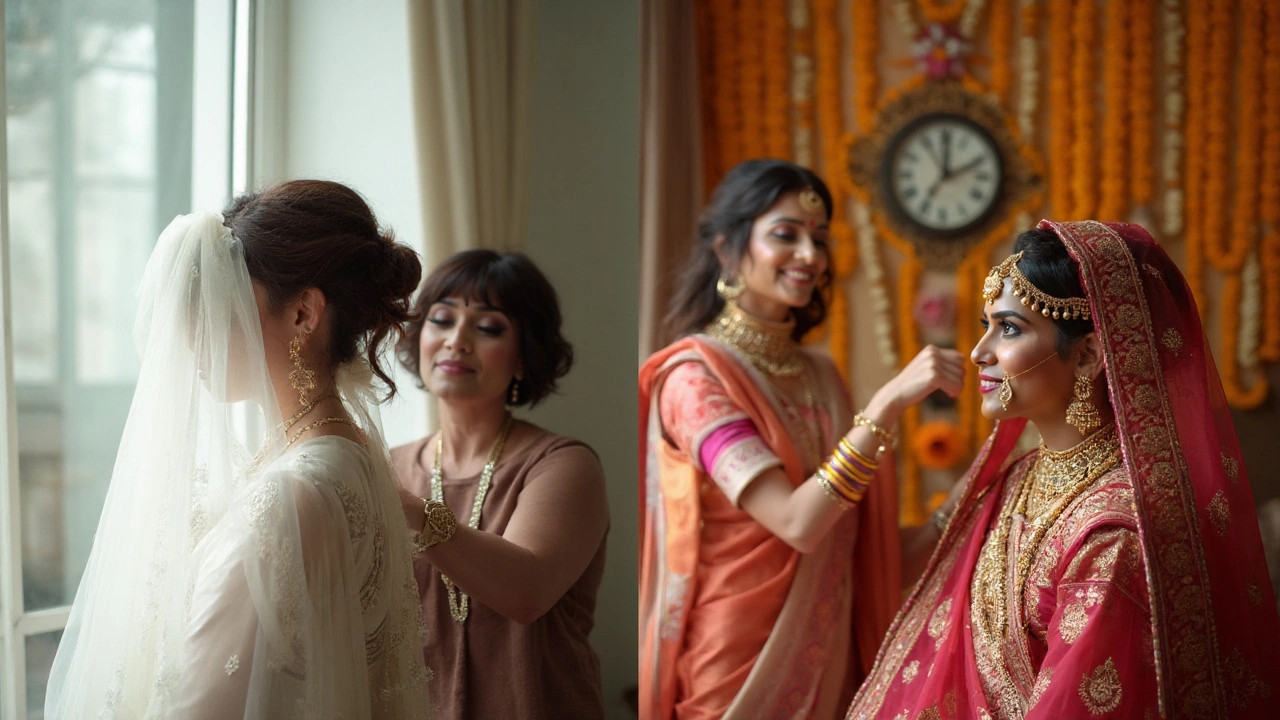
Real-World Scenarios and Sample Timelines
I’ve seen these play out dozens of times. Use what matches your day, then tweak.
1) Western church/civil ceremony, no first look, same venue
- Ceremony: 6:00 pm
- Arrival cushion: 20 minutes (arrive 5:40 pm)
- Pre‑ceremony portraits: 30 minutes (solo + parents) 5:10-5:40 pm
- Buffer: 30 minutes
- Ready by: 4:40 pm (fully dressed, touch‑ups done)
- Back‑plan start: If HMUA needs 3 hours for you plus 2 bridesmaids, start by 1:30 pm, eat by 1:10 pm
Notes: Photographer arrives by 3:30 pm for details (dress, shoes, stationery). Ask bridesmaids to finish hair/makeup before you, so they look polished in your robe shots and help you into the dress fast.
2) Western ceremony with first look and family photos before
- Ceremony: 5:30 pm
- First look + couple portraits: 60 minutes 3:40-4:40 pm
- Immediate family photos: 20 minutes 4:40-5:00 pm
- Arrival cushion: 20-25 minutes (arrive 5:05-5:10 pm)
- Buffer: 30 minutes
- Ready by: 3:10 pm
- Back‑plan start: With 2 hrs HMUA and 20-30 min draping/veil, start by 12:30-12:45 pm; lunch by 12:10 pm
3) Hindu wedding with baraat, mandap, and muhurat
- Muhurat: 9:00 am
- Baraat: 8:15-8:45 am
- Arrival cushion at mandap: 20 minutes (arrive 8:40 am)
- Pre‑ritual portraits + finishing photos: 30-40 minutes 8:00-8:40 am
- Buffer: 30-45 minutes
- Ready by: 7:20-7:30 am
- Back‑plan start: Hair 60-90, makeup 60-90, drape/dupattas/jewellery 40-50 ⇒ begin HMUA by 4:30-5:00 am. Yes, early. Worth it.
Notes: South Indian muhurthams often run even earlier. If flowers (mogra) are woven into hair, add 10-15 minutes for setting. Keep the room cool; humidity unravels curls and melts base.
4) Nikah (Muslim ceremony), separate spaces for men/women
- Nikah: 4:00 pm
- Couple portraits pre‑ceremony: 30-45 minutes 3:00-3:45 pm
- Arrival cushion: 20 minutes (arrive 3:40 pm)
- Buffer: 30 minutes
- Ready by: 2:50 pm
- Back‑plan start: If styling includes hijab setting and jewellery, add 20-25 minutes to HMUA total; begin around 12:15-12:30 pm
5) Beach/outdoor ceremony in Mumbai (sunset 6:30-7:00 pm, humid)
- Ceremony: 6:15 pm (sunset portraits after)
- No first look; pre‑ceremony portraits in AC: 30 minutes 5:25-5:55 pm
- Arrival cushion: 20 minutes (arrive 5:55 pm)
- Buffer: 30 minutes
- Ready by: 4:55 pm
- Back‑plan start: Heat‑proof hair/makeup adds 10-15 minutes; start by 2:00 pm
Why these windows work: Most planners I work with block 60-90 minutes pre‑ceremony for portraits and calm. Photographers aim to shoot details as you finish HMUA, then roll into portraits. Industry groups like Professional Photographers of America commonly suggest 30-60 minutes for couple portraits and 15-30 minutes for family, which aligns with the ranges above. WeddingWire India and major artist collectives in metros also quote 60-90 minutes for bridal HMUA, plus draping time.
Checklists, Heuristics, and a Handy Time Table
Print this section or save it to Notes. It’s the difference between “rushed” and “we’re ahead of schedule.”
Shot‑list you can complete before the ceremony (no first look):
- Dress/lehenga/saree on hanger + details (invites, rings, bangles, perfume)
- HMUA finishing touches; dupatta/veil pinning
- Bridal solo portraits (window light, full length, close‑ups)
- Parent or bridesmaid reveal
- Quick photos with mom, dad, siblings, bridal party
Heuristics that save the day:
- Hair first, then makeup, then draping, then jewellery, then veil/dupatta-photos as soon as you’re set.
- Ratio matters: 1 artist per 3-4 people. If fewer artists, start earlier or trim the number getting pro HMUA.
- Build a 20‑minute “quiet pocket” before you step out. No touch‑ups, no chores-just breathe and hydrate.
- Rain plan on paper: alternate photo spots, extra umbrellas, towel + hair pins kit.
- Pin everything. Heavy dupattas need 8-12 discreet pins. Don’t rush this.
Emergency mini‑kit (keep it in the room):
- Safety pins (assorted), double‑sided tape, fashion tape
- Mini sewing kit with the right color thread
- Oil‑control sheets, compact powder, lipstick, makeup sponge
- Bobby pins, hair spray, small comb
- Stain wipes, deodorant, mints, straw for sipping water
- Snacks: nuts, energy bar, banana; ORS or electrolyte tabs
Quick checks to run the night before:
- Are the jewellery clasps working? Any missing backings?
- Is the blouse/lehenga hem comfortable when you sit?
- Is the veil/dupatta properly steamed and packed with spare pins?
- Is the timeline printed and with your point person and HMUA?
- Have you confirmed travel time at the same hour/day of week?

Mini‑FAQ and Your Next Steps
How early should the groom be ready?
Usually 45-60 minutes before the ceremony if there’s no first look; 90 minutes before if there is one. If you want a few couple portraits without a formal first look, groom should be fully ready as you finish.
Do I need to be first for hair and makeup?
No. Start second so the artist is warmed up, finish second‑last so you’re fresh for photos. The last 15 minutes are for finesse and setting.
What if I have a large bridal party?
Either add more artists or start earlier. A good ratio is 1 artist per 3-4 people. If you keep one artist, schedule 35-50 minutes per person and add a 15‑minute reset break every two hours.
How do I handle delays without panicking?
Make your buffer real (30-45 minutes). Keep at least three photo spots within 1 minute of your room. If draping runs late, photographers can shoot details and candids in the meantime-no dead time.
Should I eat before dressing?
Yes. A small, carb‑protein snack 60-90 minutes before you put on the outfit keeps energy up and avoids makeup smudges later. Use a straw for sips after lipstick.
How do cultural rituals change the timing?
South Asian weddings often need extra time for draping, jewellery, and pre‑ritual blessings. Add 30-60 minutes on top of Western timelines. Work backward from muhurat, not baraat.
Is a first look worth the extra hour?
If you want more time at cocktail hour and fewer family photos after the ceremony, yes. It smooths the day and reduces the post‑ceremony crunch.
How do I factor in Mumbai traffic?
Check the exact route at the same weekday and hour one week prior. Add 15-20 minutes minimum. During monsoon or if crossing the Sea Link around rush hour, add 25-40 minutes.
Do photographers and planners agree with these windows?
In practice, yes. Planners in metros commonly build 60-90 minutes of pre‑ceremony breathing room; photographer associations often suggest 45-75 minutes for portraits when done ahead. It’s consistent with what I see on real wedding days.
Next steps (copy this plan):
- Pick your photo strategy: first look or not. Decide today.
- Run the formula and set your Ready By Time. Share it with HMUA, photographer, and your point person.
- Count heads for HMUA. If the math doesn’t fit, add an artist or start earlier.
- Do a route test one week prior at the same hour; adjust travel buffer.
- Pack the emergency kit tonight; pin your veil/dupatta plan with your stylist.
- Print the timeline. Give copies to the best man/maid of honor and a sibling.
One last tip from experience: a clean, quiet 20‑minute pocket before you step out changes your whole day. Your photos look calmer. Your family relaxes. Even my cat, Luna, senses the mood when I build timelines like this-everything just flows. Plan the pocket; the rest follows.
